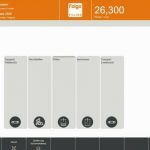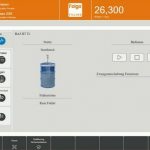Pascal Strehlau, responsible project manager at Feige Filling: “One of the biggest advantages of the WEB HMI – it is web-based. Hence, the interface can be used on virtually any end device, also on mobile phones and tablets, is platform-independent and can be operated on several devices at once. Equipped with multitouch and gesture control, operation is adapted to the usual end devices and with scrolling, touch and similar features thus offers the user a comprehensible design.”
To configure the new WEB HMI in the long term to the satisfaction of customers and employees, the developers joined forces with the service and took a look at some of the machines on site during production. It was important to them to see how the operators are coping with the current HMI and to examine the layout of the design. “This gave rise to some ideas as to how the new interface can be developed to make it as simple as possible for the operator while at the same time allowing complex contents such as statistics and filling curves to be integrated,” explains Jörn Czysch, automation engineer with Feige, who together with Pascal Strehlau forced the implementation of the WEB HMI.
User interface rethought
Putting the emphasis on the user – that was the motto for the new and improved user interface. The result is a more compact content summary that is only of relevance to the user. The simplified application allows the productivity of the operator to be increased to a high degree. The training requirement for new employees is reduced, thus shortening the familiarization periods. Besides, tasks can be completed by different employees without them requiring extensive training. Feige Filling will also integrate the new touch panel into the smaller semi-automatic machines. “Depending on the machine the customer opts for, employees will come across the same HMI both on the large and on the small machines and will need no additional training,” adds Pascal Strehlau.
Design as function
A group-wide project team has extensively dealt with the topic ‘design’ and has applied this knowledge very specifically to the product functions. The new user interface of the WEB HMI convinces with its intuitive design that makes operation easier for the user and ensures fast orientation and considerable time saving. In addition, unnecessary operating steps, accidents or operating errors are prevented. Modern items such as drop-down boxes and slide switches, with which the user is already familiar from his smartphone, increase the ease of use and substitute menu options in need of explanation. Even during the design process, Feige Filling was as closely as possible guided by customer requirements to guarantee an efficient as possible interaction.
Improved help concept
Of particular importance was to enhance the help concept so as to offer the user an even more comprehensive description of possible failures. 3-D-pictures and videos, operating instructions and PDFs support the employee in reacting quickly to alarms. In addition, an integrated commentary function permits the operator to write his own notes with regard to a particular failure. This is of great help in reminding oneself or other employees of factors that may possibly have influenced this failure.
A sophisticated layout
“The new HMI offers customers the opportunity of flexibly creating a name entry for each of their employees,” says Czysch. “In the user administration, they are able to distribute roles and rights and can for instance decide whether the operator may adjust parameters or carry out a manual operation,” explains the automation expert. The latest system feature is the logbook that is used to record different machine states and user operations. This includes among others entries of the parameters that were adjusted or the information which operator has just logged on to the system. The recipe administration in particular was a very important development issue. Although referring to the same content, the name the recipe management had been given differed across the group. A recipe in the context of the Feige WEB HMI describes a collection of parameters such as target weight, tolerances, masses, consistency, etc., which can be individually saved and exported by the customer. A recipe, e.g. milk, is made up of sub-recipes such as product or container.
Conclusion
The jointly newly developed HMI places the focus on the operator and thus convinces as ideal interface between man and machine. Increased productivity and time saving are two great advantages customers can expect to gain with the use of the WEB HMI.
Feige Filling is a pioneer in touch panel integration and has already delivered machines with the new interface. The next step is the consistent implementation of the WEB HMI across the entire Haver & Boecker Group. An existing machine can be converted to the new touch panel, provided the control system is also replaced.
“Especially for users who have machines or plants from more than one of the companies of the Haver & Boecker Group,the use of a uniform HMI would make things easier. We have oriented the development strictly to the needs of the operator. We already have ideas how the interface could be put to even broader use,” Strehlau sumps up.
Online search: Feige Filling
Hall 3.0, Booth F38












